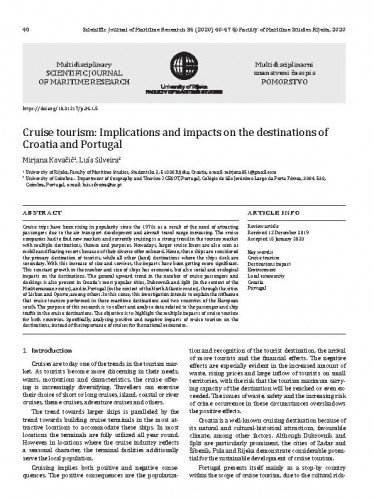Cruise trips have been rising in popularity since the 1970s as a result of the need of attracting passengers due to the air transport development and aircraft travel range increasing. The cruise companies had to find new markets and currently cruising is a strong trend in the tourism market with multiple destinations, themes and purposes. Nowadays, larger cruise liners are also seen as mobile and floating resorts because of their diverse offer onboard. Hence, these ships are considered the primary destination of tourists, while all other (land) destinations where the ships dock are secondary. With this increase of size and services, the impacts have been getting more significant. This constant growth in the number and size of ships has economic, but also social and ecological impacts on the destinations. The general upward trend in the number of cruise passengers and dockings is also present in Croatia’s most popular cities, Dubrovnik and Split (in the context of the Mediterranean routes), and in Portugal (in the context of the North Atlantic routes), through the cities of Lisbon and Oporto, among others. In this sense, this investigation intends to explain the influence that cruise tourism performed in these maritime destinations and two countries of the European south. The purpose of this research is to collect and analyse data related to the passenger and ship traffic in the cruise destinations. The objective is to highlight the multiple impacts of cruise tourism for both countries. Specifically, analysing positive and negative impacts of cruise tourism on the destinations, instead of the importance of cruises for the national economies.
Sažetak

 Pomorstvo : multidisciplinarni znanstveni časopis = multidisciplinary scientific journal of maritime research : 34, 1(2020) / glavni urednik Serđo Kos.
Pomorstvo : multidisciplinarni znanstveni časopis = multidisciplinary scientific journal of maritime research : 34, 1(2020) / glavni urednik Serđo Kos.